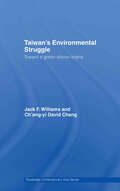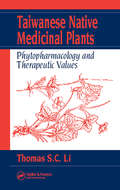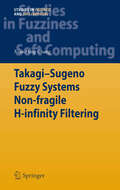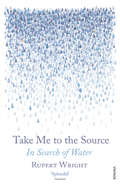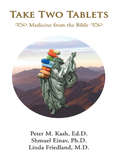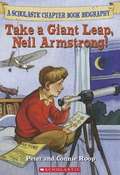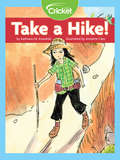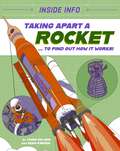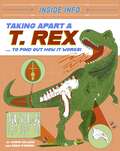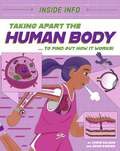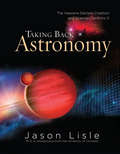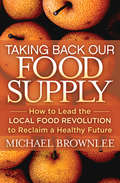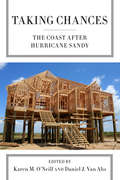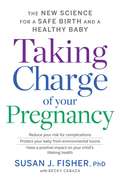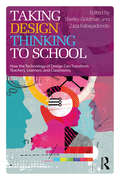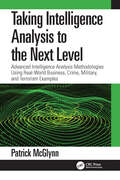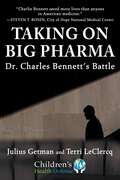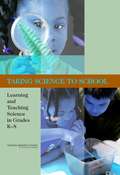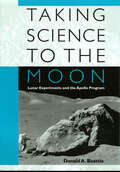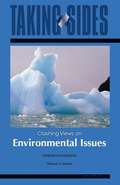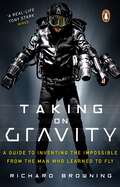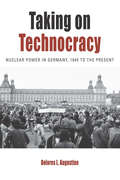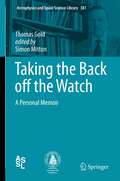- Table View
- List View
Taiwan's Environmental Struggle: Toward a Green Silicon Island (Routledge Contemporary Asia Series)
by Jack Williams Ch’ang-yi David ChangTaiwan experienced a highly successful economic transformation in the last 50 years that produced one of Asia’s genuine ‘miracles’ of modern development, in terms of improvement in per capita income and overall quality of material well being for its citizens. The process, though, involved rapid industrialization and urbanization, and breakneck mass consumption, that inevitably resulted in rapid escalation in degradation of the island’s fragile air, water, and land, and produced some of the worst environmental pollution to be found anywhere in Asia This book examines the causes of Taiwan's environmental predicament, engaging in Taiwan's unique geological, geographical, demographical, political, industrial, historical and economic circumstances. In addition, Jack Williams and Ch'ang-yi David Chang assess the efforts of the government, NGOs and private citizens to create a "green" environmentally sustainable island, with a high tech economy based on the silicon chip, the backbone of Taiwan’s highly successful IT industry. Finally the authors discuss what can be done to improve Taiwan's environmental future. As the first commercially available book in English on Taiwan’s environmental problems this is an invaluable read for students and scholars interested in environmental studies, sustainable development and the island of Taiwan.
Taiwanese Native Medicinal Plants: Phytopharmacology and Therapeutic Values
by Thomas S. LiWritten by internationally renowned scientist and author Thomas S.C. Li, Taiwanese Native Medicinal Plants presents information critical to assessing the medicinal potential of Taiwanese herbs. A comprehensive review of chemical constituents, toxicity, and therapeutic values, the book focuses on documentation of the chemical components present and
Takagi-Sugeno Fuzzy Systems Non-fragile H-infinity Filtering
by Xiao-Heng ChangTakagi-Sugeno Fuzzy Systems Non-fragile H-infinity Filtering investigates the problem of non-fragile H-infinity filter design for Takagi-Sugeno (T-S) fuzzy systems. Given a T-S fuzzy system, the objective of this book is to design an H-infinity filter with the gain variations such that the filtering error system guarantees a prescribed H-infinity performance level. Furthermore, it demonstrates that the solution of non-fragile H-infinity filter design problem can be obtained by solving a set of linear matrix inequalities (LMIs). The intended audiences are graduate students and researchers both from the fields of engineering and mathematics. Dr. Xiao-Heng Chang is an Associate Professor at the College of Engineering, Bohai University, Jinzhou, Liaoning, China.
Take Me to the Source: In Search of Water
by Rupert WrightColourless, tasteless, odourless, ageless: water is both the simplest thing on earth and the most complex. We cannot live without it yet it kills six thousand children a day. It is the ultimate renewable resource but we pollute it without thinking twice. Why, if water is so valuable does nobody want to pay for it unless it comes in a designer bottle? Is it really the oil of the twenty-first century? Will we all soon be fighting over it, or can it lead countries into co-operation rather than conflict? In this enthralling voyage of discovery, Rupert Wright sets out to discover exactly what water is and why it plays such an important role in history, culture, art and literature. Part reportage and part personal journey, Take Me to the Source is the fascinating story of the substance that makes life on earth possible.
Take Two Tablets: Medicine from the Bible
by Ed. D. Shmuel Einav Linda Friedland Peter M. KashGreat nutrition, exercise, healing pathways, meditation, the importance of sex, joy, a life of meaning: TAKE TWO TABLETS: Medicine from the Bible reveals how ancient principles --as told in the Bible-- have been verified by today's scientific scrutiny and hold the keys to a healthier, longer life and how to apply them to today's hectic lifestyles. It shows us how to deal with pain, suffering, work, and stress and how these proven healing techniques resonate with all the world's major traditions as well as specific Asian health practices that promote robust health and vitality.
Take a Giant Leap, Neil Armstrong! (Before I Made History)
by Peter Roop Connie RoopScholastic Chapter Book, Biography of Neil Armstrong, the first man on the moon and what he was like as a young boy. <P><P>Lexile Measure: 720L
Take a Hike!
by Kathiann M. KowalskiEach year, more than 250 hikers need assistance at the Grand Canyon. If you plan ahead and use safety smarts, you can avoid becoming number 251! And you can have a great hiking adventure.
Taking Apart a Rocket: ... to find out how it works! (Inside Info #3)
by Chris OxladeFor any kid who's ever wanted to take a rocket apart to see how it works - this book invites you to slice, dice and delve into these amazing machines!Inside Info: Taking Apart a Rocket is a feast of facts, figures, diagrams and details with no layer unexplored. Pull apart all the rocket's stages, fuel tanks, engine parts, boosters, thrusters, exhaust systems, on-board controls, crew modules, escape systems, even space suits and splash-down parachutes! The Inside Info book series dives into the layers of things kids are curious about, exploring the science and tech through funky cross-sections, exploded diagrams, lots of labels, jokes and easter-egg details to discover. Written by experienced tech and science author Chris Oxlade, with fun and stylish art by Sean O'Brien, it's perfect for readers aged 7+.The series presents the Inside Info of: A Supercar, A Rocket, A Rollercoaster, A T. rex, The Human Body and A Coral Reef
Taking Apart a T. rex: ... to find out how it works! (Inside Info #5)
by Chris OxladePeel back, take apart and get inside the awesome science of a T. rex, then put it back together again!Inside Info: Taking Apart a T. rex is full of the razor-sharp, super-sturdy and essential structures that made up this fierce predator. From the innermost to the outermost body bits - including the interior of its tough bones, its surprisingly small brain and its layers of protective skin - we get to know the parts and processes that kept a T. rex running. Finally, see how we know so much about the T. rex's insides through the amazing science of palaeontology putting the pieces together.Contents include: The world of T. rex / Inside a T. rex / Skeleton / Leg bones / Slicing into a Bone / Muscles / Inside its head / T. rex mouth (teeth, tongue and jaw) / T. rex brain / T. rex sense organs / T. rex's Torso / Inside an egg / Putting a T. rex togetherInside Info is a stylish and engrossing series of books diving into the layers of things kids are curious about - giving them the chance to pull it all apart and put it back together again, while learning STEM fundamentals! Full of cross-sections, cutaways, exploded diagrams, labels, jokes and easter-egg details for the curious reader aged 7+ to discover.The series presents the Inside Info of: A Supercar, A Rocket, A Rollercoaster, A T. rex, The Human Body and A Coral Reef
Taking Apart the Human Body: ... to find out how it works! (Inside Info #1)
by Chris OxladePeel back, take apart and get inside the awesome science of the human body, then put it back together again!Inside Info: Taking Apart the Human Body is full of the fast-pumping, electric and surprising features of our insides. Working inwards from the outermost body bits - our millions of hairs and many layers of protective skin - to the very centre of our bones, we get to know the parts and processes keeping our body running. Finally, see how our cells build up and bring together each part, and how doctors get up-close 'inside info' every day using amazing tech, such as, MRIs, X-rays and ultrasound.Inside Info is a stylish and engrossing series of books diving into the layers of things kids are curious about - giving them the chance to pull it all apart and put it back together again, while learning STEM fundamentals! Perfect for readers aged 7 and up.The series presents the Inside Info of: A Supercar, A Rocket, A Rollercoaster, A T. rex, The Human Body and A Coral Reef
Taking Back Astronomy
by Dr Jason Lisle"This book is meant to be an introduction only - a starting point to a biblical view of the universe. . . . Who knows what amazing truths are waiting to be discovered if only the shackles of secular thinking are removed. Now is the time of discovery..." Take a breathtaking look at the universe that is comprehensive guide to the heavens! Sit back and explore the world at your fingertips in this book which: Explains the scale and size of the universe that is hard for our minds to imagine - yet can only indicate the Master's hand at work. Over 50 full-color, rarely seen photos of stars, nebulas, and galaxies. Filled with facts that challenge secular theories and models of the universe - how it began and how it continues to amaze the scientific community. Explores numerous evidences that point to a young universe: magnetic poles of planets, the spiral shape of galaxies, comets and how long scientists think they can last, and much more. With a doctorate in astrophysics from the University of Colorado, Dr. Jason Lisle is your guide to the universe beyond our world in this remarkable book. Step out among the stars and experience the truly awesome power of God through this glimpse of His vast creation.
Taking Back Our Food Supply: How to Lead the Local Food Revolution to Reclaim a Healthy Future
by Michael BrownleeSeven steps you can take NOW to ignite a local food revolution and help reverse the devastation of the industrial food system! Our food supply has been hijacked by an unholy alliance of multinational corporations in big agriculture, big food, and big pharma. This industrial food complex is destroying our natural food supply, making us less healthy, and rapidly destroying the biosphere. Restoring food sovereignty and security is one of the most important causes of our time—requiring nothing less than a grassroots revolution. In Taking Back Our Food Supply, Michael Brownlee shows readers how to master the seven steps of building a resilient regional foodshed and illustrates how to ignite the local food revolution in their community to a radically increased impact, effectiveness, and scale.
Taking Chances: The Coast after Hurricane Sandy
by Joanna Burger Tammy L. Lewis Kenneth A. Gould Robert B. Gramling Mark Alan Hewitt Mariana Leckner Bonnie Mccay Briavel Holcomb Angela Oberg Melanie Mcdermott Steven G. Decker Professor Karen M. O'Neill Patricia M. Clay Daniel Redlaswk Frank A. Felder Clinton J. Andrews Adelle Thomas Lisa L. Colburn Larry Niles Daniel Baldwin Hess David A. Robinson Brian W. Conley James K. Mitchell Ashley Koning Shankar Chandramowli Daniel J. Van Abs Julia FlaggHumanity is deeply committed to living along the world's shores, but a catastrophic storm like Sandy--which took hundreds of lives and caused many billions of dollars in damages--shines a bright light at how costly and vulnerable life on a shoreline can be. Taking Chances offers a wide-ranging exploration of the diverse challenges of Sandy and asks if this massive event will really change how coastal living and development is managed. Bringing together leading researchers--including biologists, urban planners, utilities experts, and climatologists, among others--Taking Chances illuminates reactions to the dangers revealed by Sandy. Focusing on New Jersey, New York, and other hard-hit areas, the contributors explore whether Hurricane Sandy has indeed transformed our perceptions of coastal hazards, if we have made radically new plans in response to Sandy, and what we think should be done over the long run to improve coastal resilience. Surprisingly, one essay notes that while a large majority of New Jerseyans identified Sandy with climate change and favored carefully assessing the likelihood of damage from future storms before rebuilding the Shore, their political leaders quickly poured millions into reconstruction. Indeed, much here is disquieting. One contributor points out that investors scared off from further investments on the shore are quickly replaced by new investors, sustaining or increasing the overall human exposure to risk. Likewise, a study of the Gowanus Canal area of Brooklyn shows that, even after Sandy swamped the area with toxic flood waters, plans to convert abandoned industrial lots around the canal into high-density condominiums went on undeterred. By contrast, utilities, emergency officials, and others who routinely make long-term plans have changed operations in response to the storm, and provide examples of adaptation in the face of climate change. Will Sandy be a tipping point in coastal policy debates--or simply dismissed as a once-in-a-century anomaly? This thought-provoking collection of essays in Taking Chances makes an important contribution to this debate.
Taking Charge of Your Pregnancy: The New Science for a Safe Birth and a Healthy Baby
by Dr. Susan J. FisherAn indispensable guide to the revolutionary advances in pregnancy and childbirth, Taking Charge of Your Pregnancy contains trailblazing science that explains: Why the first eight weeks are the most important and how to optimize themWhich prenatal genetic tests are risk‑free and which are a waste of moneyWhy miscarriages are common and the preventive steps future moms can takeWhen to be concerned about nauseaWhat pregnant women can learn from their own mother&’s birth storiesWhat to do about pain during labor and deliveryAfter decades of research into how babies develop in the womb, Susan J. Fisher, PhD, shares her expert advice to empower expecting parents. Complete with helpful illustrations, practical tips, and the essential questions to ask healthcare providers, here is everything you need to take charge of your health and your baby&’s.
Taking Charge: The Electric Automobile In America
by Michael Brian SchifferA history of electric cars.
Taking Design Thinking to School: How the Technology of Design Can Transform Teachers, Learners, and Classrooms
by Shelley Goldman Zaza KabayadondoDesign thinking is a method of problem-solving that relies on a complex set of skills, processes and mindsets that help people generate novel solutions to problems. Taking Design Thinking to School: How the Technology of Design Can Transform Teachers, Learners, and Classrooms uses an action-oriented approach to reframing K-12 teaching and learning, examining interventions that open up dialogue about when and where learning, growth, and empowerment can be triggered. While design thinking projects make engineering, design, and technology fluency more tangible and personal for a broad range of young learners, their embrace of ambiguity and failure as growth opportunities often clash with institutional values and structures. Through a series of in-depth case studies that honor and explore such tensions, the authors demonstrate that design thinking provides students with the agency and compassion that is necessary for doing creative and collaborative work, both in and out of the classroom. A vital resource for education researchers, practitioners, and policymakers, Taking Design Thinking to School brings together some of the most innovative work in design pedagogy.
Taking Intelligence Analysis to the Next Level: Advanced Intelligence Analysis Methodologies Using Real-World Business, Crime, Military, and Terrorism Examples
by Patrick McGlynnTaking Intelligence to the Next Level: Advanced Intelligence Analysis Methodologies Using Real-World Business, Crime, Military, and Terrorism Examples examines intelligence gathering and analysis and the significance of these programs. Coverage assumes a basic understanding of the intelligence cycle and processes, and the book builds upon the author’s previous text, Intelligence Analysis Fundamentals—also published by CRC Press—to further address various types of intelligence, the function and increasing usage of intelligence in both the private and public sectors, and the consumption of intelligence products to inform strategic decision-making. Developed for a classroom environment, chapters are packed with multiple examples, visuals, and practical exercises tailored for the intelligence community (IC), military intelligence analyst, criminal, or business analyst alike. The text begins with a chapter on analytical ethics, an important topic that sets the tone for those to come that cover intelligence gathering analytical techniques. The author utilizes multiple instructive learning approaches to build on the student’s existing analytical skills gained from other training resources, their experience, or some other combination. While topics covered are germane to all intelligence analysis fields—including military, national, political, criminal, and business—specific chapters and sections and most instructional examples, scenarios, exercises, and learning activities focus on the Homeland Security Mission and the associated problem sets. The training presentation methods and instructional approaches are the product of much thought, research, and discussion, and a variety of US government and commercial analytical training methodologies are presented. The book closes with a final chapter looking at future trends in intelligence analysis. Key Features: Provides tools to challenge intelligence assessments systematically and objectively, a prerequisite to vetted intelligence conclusions Outlines diagnostic techniques to explain events or data sets, anticipate potential outcomes, predict future trends, and make decisions for optimal outcomes Details how to conduct research to effectively write, edit, format, and disseminate reports to best effect An accompany Instructor’s Guide, for use in the classroom, contains the same practical exercises as those found in the student text, as well as facilitator’s guides, practical exercise solutions, discussion points, sample test questions, and answer keys, to include other websites that can provide additional instructional content. Taking Intelligence to the Next Level serves as an essential course textbook for programs in intelligence, terrorism, and Homeland Security in additional to serving a useful reference for practiving professionals. Ancillaries including PowerPoint lecture slides, as well as the Instructor’s Guide with Test Bank, are available for qualified course adopters.
Taking On Big Pharma: Dr. Charles Bennett's Battle (Children’s Health Defense)
by Julius Getman Terri LeClercqThe battle between Big Pharma and scientific integrity Larger-than-life, creative, and fiercely ambitious, Dr. Charlie Bennett has a long history of revealing dangerous side effects of bestselling medicines. In 2006, his meta-analysis of existing data showed that top-selling ESAs (erythropoietin stimulating agents) created previously unrecognized risks, deaths, and serious illness. According to Dr. Steven Rosen, chief medical officer of the City of Hope Cancer treatment center, Bennett &“saved more lives than anyone in American medicine.&” Bennett&’s work also created enemies: Bennett was accused, on the basis of flimsy evidence, of mishandling government grant money and violating the False Claims Act. Powerful interests within Big Pharma, academia, and law enforcement joined in the attack on Bennett. By 2010, he was forced from his academic position; was besieged by lawsuits; and became the victim of a coordinated, well-funded campaign to discredit him and refute his work. From pharma superstar to disgrace and disrepute in the blink of an eye. Taking On Big Pharma explores Bennett&’s achievement and evaluates the charges against him. Exposed is the unsettling relationship between the pharmaceutical industry and academia. The result of more than five years of research and hundreds of hours of interviews with scientists, academicians, and federal prosecutors, this is an unflinching look at how institutions, purportedly devoted to public health and education, can be corrupted for profit—from drug sales or research grants.
Taking Science to School: Learning and Teaching Science in Grades K-8
by National Research Council of the National AcademiesWhat is science for a child? How do children learn about science and how to do science? Drawing on a vast array of work from neuroscience to classroom observation, Taking Science to School provides a comprehensive picture of what we know about teaching and learning science from kindergarten through eighth grade. By looking at a broad range of questions, this book provides a basic foundation for guiding science teaching and supporting students in their learning. Taking Science to School answers such questions as: *When do children begin to learn about science? Are there critical stages in a child's development of such scientific concepts as mass or animate objects? *What role does nonschool learning play in children's knowledge of science? *How can science education capitalize on children's natural curiosity? *What are the best tasks for books, lectures, and hands-on learning? *How can teachers be taught to teach science? The book also provides a detailed examination of how we know what we know about children's learning of science--about the role of research and evidence. This book will be an essential resource for everyone involved in K-8 science education--teachers, principals, boards of education, teacher education providers and accreditors, education researchers, federal education agencies, and state and federal policy makers. It will also be a useful guide for parents and others interested in how children learn.
Taking Science to the Moon: Lunar Experiments and the Apollo Program (New Series in NASA History)
by Donald A. BeattieHow did science get aboard the Apollo rockets, and what did scientists do with the space allotted to them? Taking Science to the Moon describes, from the perspective of NASA headquarters, the struggles that took place to include science payloads and lunar exploration as part of the Apollo program. Donald A. Beattie—who served at NASA from 1963 to 1973 in several management positions and finally as program manager, Apollo Lunar Surface Experiments—here supplies a detailed, insider's view of the events leading up to the acceptance of science activities on all the Apollo missions.
Taking Science to the Moon: Lunar Experiments and the Apollo Program (New Series in NASA History)
by Donald A. BeattieA former NASA scientist shares a behind-the-scenes history of the Apollo space program and the fight to include science activities in the missions.In 1961, President Kennedy set a goal of putting a man on the moon in order to assert American dominance in the escalating Cold War. The mission’s sole purpose was to beat the Soviets to the punch. So how did science get aboard the Apollo rockets? And what did scientists do with the space allotted to them? Donald A. Beattie served at NASA from 1963 to 1973 in several management positions, including as program manager of Apollo Lunar Surface Experiments. In Taking Science to the Moon, Beattie takes readers inside NASA headquarters and the struggle to include science payloads and lunar exploration as part of the Apollo program.
Taking Sides: Clashing Views on Environmental Issues
by Thomas EastonTaking Sides: Clashing Views on Environmental Issues, Thirteenth Edition, is a debate-style reader designed to introduce students to controversies in environmental policy and science. The readings, which represent the arguments of leading environmentalists, scientists, and policy makers, reflect opposing positions and have been selected for their liveliness and substance and because of their value in a debate framework.
Taking on Gravity: A Guide to Inventing the Impossible from the Man Who Learned to Fly
by Richard Browning**As seen on Top Gear**'Richard Browning is a real-life Tony Stark.' - Wired---------------For fans of Adrian Newey, Guy Martin and Chris Hadfield, in Taking on Gravity inventor Richard Browning tells the inspiring story behind his iconic jet suit, and shares his creative principles for generating true innovation.From Icarus to Iron Man, the dream of human flight has always inspired and challenged us. Now, with his pioneering jet suit, Richard Browning has redefined what is possible.Richard Browning's story is one of groundbreaking innovation. Building an aviation business from his garage, he has invented a whole new form of personal flight - a fantasy previously reserved for the pages of science fiction. His iconic jet suit has captured the imaginations of millions around the world, triggered ongoing developments in technology and engineering, and inspired a new generation of creative minds to pursue their dreams.In Taking on Gravity, Browning reveals the creative principles of his multimillion-pound company, Gravity Industries, and shows us how grass-roots innovation can disrupt established industries in exciting and unexpected ways. On this journey into the sky we'll experience what it's like to take flight, to test the limits of the human body, and to convert moonshot ideas into tangible results.The Gravity story is an inspiring example of human creativity and our ceaseless desire to push the boundaries of what is possible. Where we go next is up to you.READERS LOVE THE 'TAKING ON GRAVITY' STORY***** 'Tony Stark Lite'***** 'Must read for anyone looking for inspiration to continue pursuing their dream'***** 'Taking on Gravity by Richard Browning is equal parts inspiring, inquisitive, soulful and ultimately a fantastic read that I will return to again.'
Taking on Technocracy: Nuclear Power in Germany, 1945 to the Present (Protest, Culture & Society #24)
by Dolores L. AugustineThe German abandonment of nuclear power represents one of the most successful popular revolts against technocratic thinking in modern times—the triumph of a dynamic social movement, encompassing a broad swath of West Germans as well as East German dissident circles, over political, economic, and scientific elites. Taking on Technocracy gives a brisk account of this dramatic historical moment, showing how the popularization of scientific knowledge fostered new understandings of technological risk. Combining analyses of social history, popular culture, social movement theory, and histories of science and technology, it offers a compelling narrative of a key episode in the recent history of popular resistance.
Taking the Back off the Watch
by Simon Mitton Thomas GoldThomas Gold (1920-2004) had a curious mind that liked to solve problems. He was one of the most remarkable astrophysicists in the second half of the twentieth century, and he attracted controversy throughout his career. Based on a full-length autobiography left behind by Thomas Gold, this book was edited by the astrophysicist and historian of science, Simon Mitton (University of Cambridge). The book is a retrospective on Gold's remarkable life. He fled from Vienna in 1933, eventually settling in England and completing an engineering degree at Trinity College in Cambridge. During the war, he worked on naval radar research alongside Fred Hoyle and Hermann Bondi - which, in an unlikely chain of events, eventually led to his working with them on steady-state cosmology. In 1968, shortly after their discovery, he provided the explanation of pulsars as rotating neutron stars. In his final position at Cornell, he and his colleagues persuaded the US Defense Department to fund the conversion of the giant radio telescope at Arecibo in Puerto Rico into a superb instrument for radio astronomy. Gold's interests covered physiology, astronomy, cosmology, geophysics, and engineering. Written in an intriguing style and with an equally intriguing foreword by Freeman Dyson, this book constitutes an important historical document, made accessible to all those interested in the history of science.
